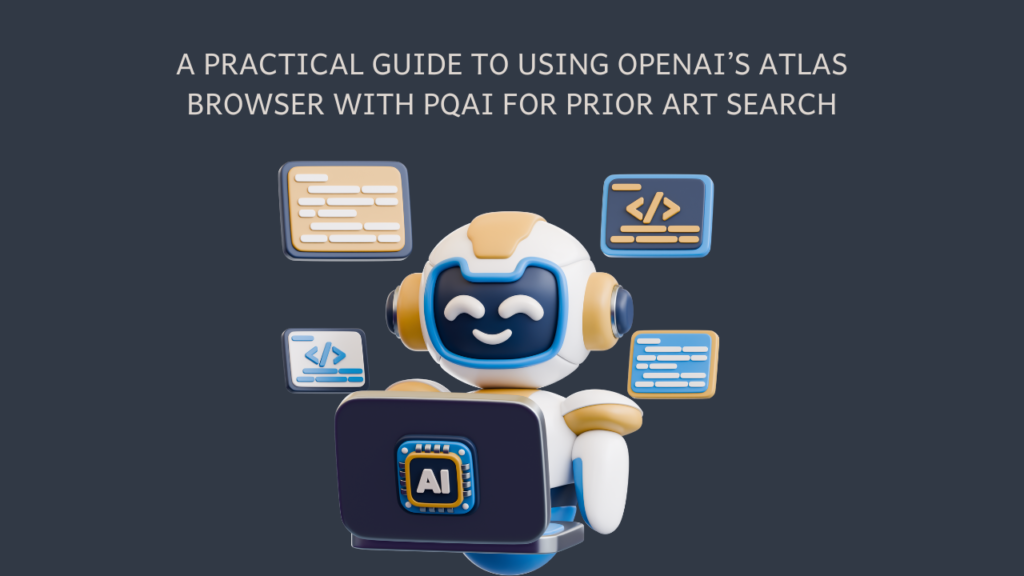
A Practical Guide to Using OpenAI’s Atlas Browser With PQAI for Prior Art Search
OpenAI’s Atlas browser marks a new milestone in AI-driven research. Research on the web has always been a bit awkward for AI. It could fetch

Imagine this: you design a smart blender that measures nutrition as you add ingredients. Excited, you type “nutrition tracking blender” into a patent search engine and find nothing close. It feels like a green light. So you file a patent.
Months later, after the drafting and filing costs pile up, you discover the idea was already patented under the term “dietary analysis food processor.” Different words, same concept.
That’s the risk of keyword-based patent search. It only finds what you type, leaving the most relevant prior art invisible. For inventors and startups, that blind spot can mean the difference between protecting an idea and losing it.
This is where AI-based patent search tools change the game. They don’t just scan for keywords. They surface patents that describe ideas in different terms, highlight overlapping concepts, and even connect the dots with scientific papers.
So which tool should you choose? To help you, we created this article, where we’ll look at 14 top AI patent search tools as of 2025. Let’s dig in.
You see, AI patent search tools don’t just scan text; they interpret it.
Some rely on semantic models that understand meaning in plain sentences. While others use graph-based representations that map technical features. A few specialize in image recognition, making it easier to spot overlaps in designs. And some build citation networks to uncover hidden relationships between inventions.
Each approach gives you a different lens into prior art. Together, these tools make patent searching faster, sharper, and far more insightful than traditional methods.
Here are 14 platforms leading the way in 2025:
Let’s dive in with the first tool in the list.
PQAI is an open-source patent search engine built to make prior art search accessible to everyone. With PQAI, you don’t need Boolean strings or class codes. All you have to do is type your idea in plain English. The system uses semantic AI to find conceptually similar patents and related technical literature.
The platform draws on a large dataset of patent documents and research papers, including patents from 68 major patent offices and over 100 million research papers.

Source – PQAI
Each result offers relevant snippets so you can check overlap without reading documents in full.
Spearheaded by Sam Zellner, PQAI is best suited for inventors, students, and startups running early novelty or freedom-to-operate checks. Its focus on transparency and open access makes it a practical first step before moving into more specialized or paid platforms.
PQAI is more than just a semantic search engine. It comes with practical add-ons that make patent searching smarter, faster, and useful for both first-time inventors and advanced users.
CPC/IPC Lookup: Patent classes often decide whether your search goes deep or stays shallow. PQAI suggests the most relevant CPC and IPC codes based on your description, so even if you don’t know classification systems, you can still target the right technology areas. Advanced users can refine results further by focusing on specific codes.
Similar Keywords Finder: Patents describe the same invention in dozens of ways. PQAI surfaces related terms and synonyms tied to your query. This widens the net and reduces the chance of missing prior art just because you didn’t type the “official” wording.
Concept Extractor: You can drop in a long or complex invention idea, and PQAI breaks it down into its core concepts automatically. This helps highlight the inventive elements that really matter, and keeps your search focused on the right pieces of prior art.
GAU Predictor: Knowing where your application will land at the USPTO can shape your strategy. PQAI predicts the most likely Group Art Unit (GAU) and shows examiner allowance rates, giving you visibility into how similar inventions have been treated.
Private Server Deployment: For enterprises with strict data security needs, PQAI can be deployed on a private server. This way, all queries and results stay within your organization, while still benefiting from PQAI’s AI-driven engine.
With PQAI+ and enterprise plans, teams can also integrate semantic search into their own systems. From running up to 50 daily queries with PQAI+ to scaling thousands per month on enterprise, the API automates searches and keeps workflows running smoothly.
Whether you’re an advanced user or just starting out, PQAI offers tools that adapt to your level and help you search with confidence. Start your search with PQAI today.
PQAI offers three plans: Free, PQAI+, and Enterprise, each designed for different needs.
The Free plan gives basic web searches with up to 20 results per query, while PQAI+ ($20/month) adds faster speed, exports, and limited API access for individual power users.
For teams and enterprises, the plan unlocks up to 6,000 API requests, bulk data, private workflows, and priority support.
IPRally is built around their proprietary Graph AI to help you search patents by idea, not just by keywords.
It includes natural language search, publication-number input, and filters, plus support for image-based search and patent reviews with relevance-feedback.
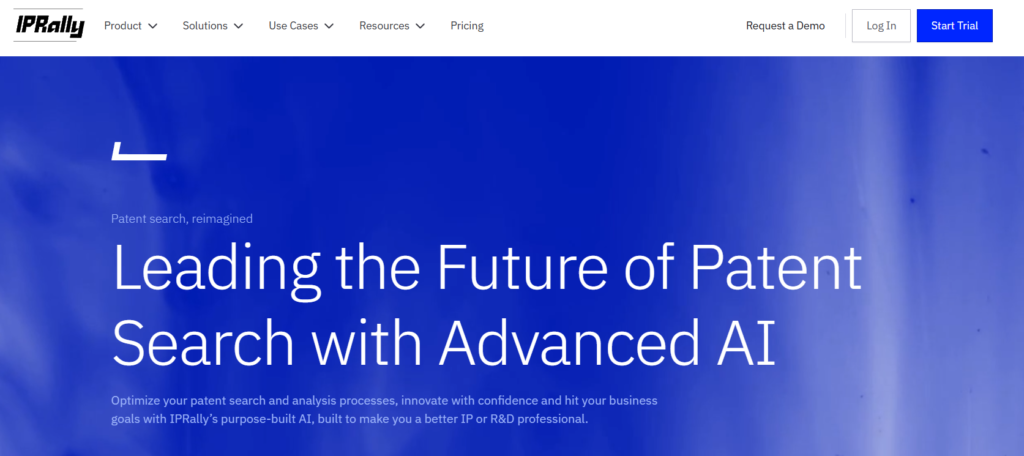
Source – IPRally
The platform covers 58 jurisdictions and over 120 million patents, including full-text and machine translations for non-English documents. It lets you classify your results using your own taxonomy, manage portfolios, export data, and collaborate via team licenses.
It is best suited for patent professionals, IP teams, or R&D departments that need deeper searches, monitoring, or large portfolios.
Pricing: The pricing information is tiered by plan (Individual, Team) and is available via sales contact.
Ambercite is a patent discovery platform built around citation networks rather than keywords or semantics. It analyzes a global database of over 106 million patents and 175 million citations to rank the most relevant documents.
This approach helps uncover prior art, licensing opportunities, and portfolio insights that traditional keyword or semantic tools may overlook.

Source – Ambercite
The engine behind Ambercite powers all its products, from Ambercite AI searches to AmberScope’s interactive visualizations, where users can explore citation networks in a more intuitive way.
With smart review panes, family-to-family analysis, and representative images, the platform is designed to save time and reduce missed results. Ambercite is best suited for patent professionals, licensing teams, and portfolio analysts.
Pricing: Pricing is subscription-based, with free trials available.
Patentfield is a Japan-based patent search and analysis platform that combines full-text, semantic, Boolean, and image-based search.
Users can enter keywords, applicants, or patent numbers, or upload drawings to run similar image searches across patent and design publications.

Source – Patentfield
Its AI has been trained on millions of patents, enabling it to recognize synonyms and context (e.g., “solar panel” vs. “photovoltaic power generation panel”).
The tool also supports AI classification, allowing users to train models on sample data and automatically score or group up to 100,000 patents. For analytics, Patentfield provides 120+ visualization methods, including citation maps, timelines, heatmaps, and portfolio scoring.
Their coverage includes Japan, US, Europe, PCT/WO, and Taiwan.
Pricing: Pricing starts at $100/month (Basic plan), while enterprise plans with higher limits and workflow features are available on request.
PatSeer is a patent search and analysis platform that combines Boolean, semantic, and AI-powered search in one system.
Users can run full-text searches, apply advanced filters, or leverage AI to refine results, summarize documents, and recommend related patents.
For design patents, it also supports AI-driven image similarity search, making it possible to compare drawings and visual features.
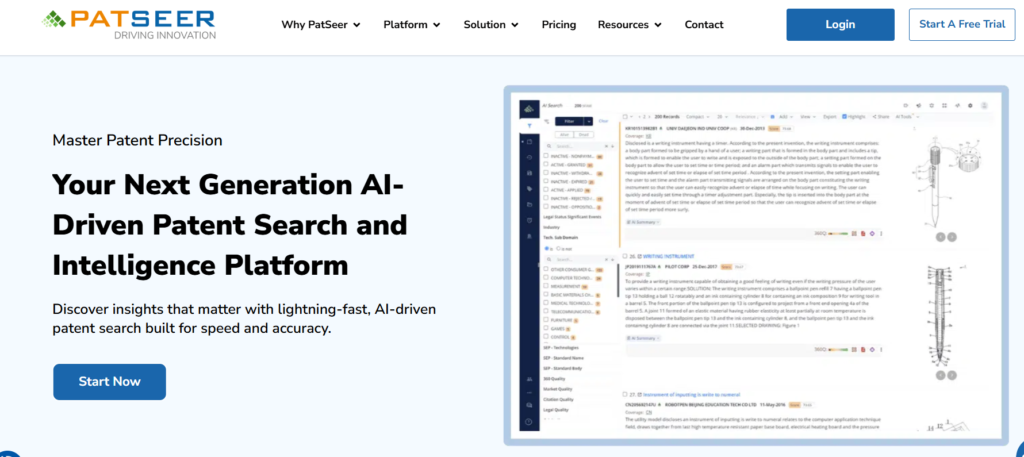
Source – PatSeer
The database covers global patents and industrial designs, enriched with value-added content and national classification data. Alongside search, PatSeer also offers analytics tools such as citation maps, co-occurrence matrices, and trend charts to support portfolio evaluation and technology landscaping.
Pricing: Multiple editions are available, but detailed pricing is not publicly disclosed. Access is typically provided through subscription, with trial options on request.
Global Patent Search is designed to make prior art search both intuitive and comprehensive.
The tool offers access to patent data from major patent offices along with non-patent literature, helping users uncover not only recent filings but also foundational research.
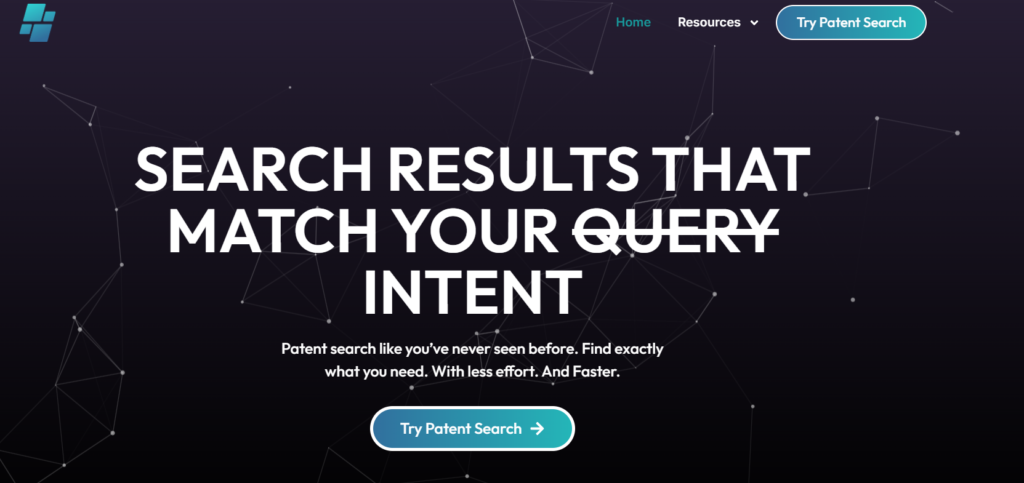
Source – Global Patent Search
The platform supports both natural language queries and keyword-based search. In fact, if a user enters a patent number to find prior art, it is automatically translated into natural language. Users can then refine the query further or leave it as is, and GPS retrieves semantically matched results.
They also offer advanced filters that let you narrow searches by jurisdiction, publication type, or timeframe, and you can exclude backward citations, family members of the subject patent, and family members of cited patents. Each result comes with relevant snippets to reduce manual reading.
With API access available, the tool integrates smoothly into enterprise workflows, making it suitable for both independent inventors and R&D teams. Its focus on bridging historical data with emerging trends positions it as a versatile platform for novelty checks, FTO analysis, and technology landscaping.
Pricing: Their Pricing information is not publicly available. You’ll need to contact their team for a quote.
Amplified is an AI-powered patent search and collaboration platform designed to simplify prior art discovery. The tool applies document-level AI similarity, analyzing the entire text of over 140 million patents to surface conceptually related results.
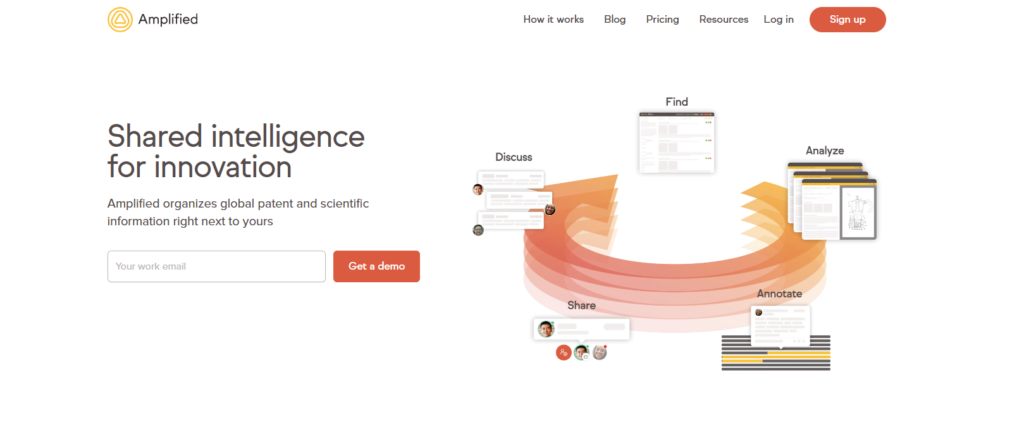
Source – Amplified
Whether starting from plain text, an invention disclosure, or an existing patent, the platform ranks results by relevance and lets users refine them further with Boolean filters and keyword highlights.
Beyond search, Amplified is built for collaboration. Teams can annotate patents, share projects, and track workflows for activities like invention disclosures, invalidity studies, and monitoring. Family data, citations, and legal status are included, with global coverage updated weekly and English machine translations available.
Pricing: Subscription-based with free trials and team plans available on request.
NLPatent is an AI-driven patent search and analysis platform built on their proprietary large language models trained to understand the contextual nuances of patent language.
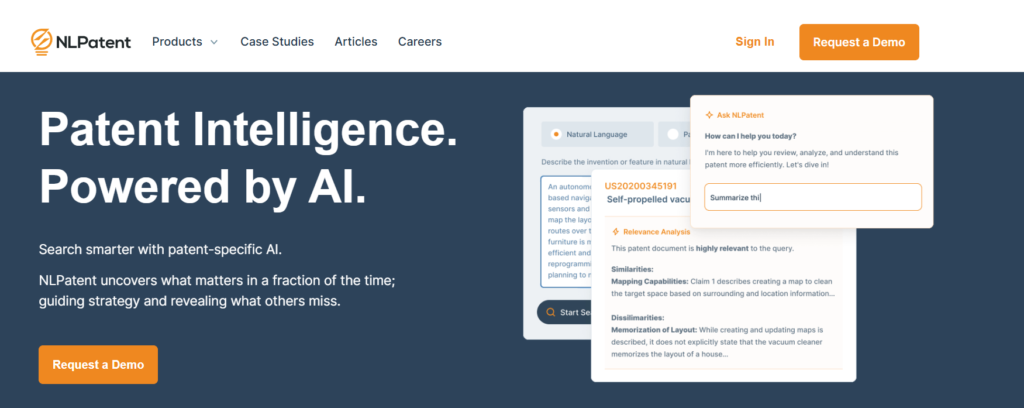
Source – NLPatent
Instead of focusing on surface-level matches, it delivers conceptual, context-aware results designed to speed up novelty, invalidity, and FTO searches. The system includes features like real-time relevance analysis, claim scoping, and automated comparisons, making it adaptable to prosecution, licensing, and due diligence workflows.
Its database integrates explainability so users can see why results are ranked. Security is emphasized through SOC 2 certification and strict data privacy controls, ensuring searches remain confidential.
Pricing: Subscription-based, with no public pricing disclosed. Quotes and demos are available directly from the NLPatent team.
Octimine is an AI-powered platform for global patent search and analysis.
It combines Boolean logic, semantic AI, and deep learning to retrieve relevant prior art from a worldwide patent dataset of over 150 million patents and more than 210 million non-patent literature documents.
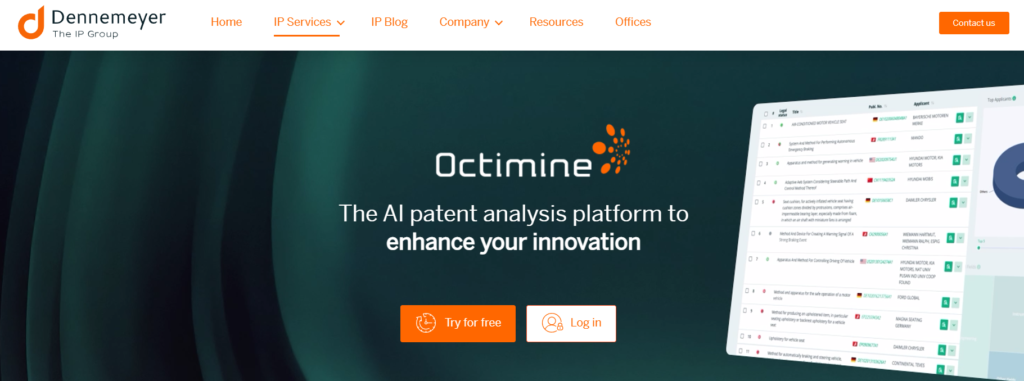
Source – Octimine
The tool supports multiple workflows, including novelty checks, landscape analysis, competitor monitoring, and portfolio review.
Their built-in analytics provide interactive visualizations, while collaboration features let teams share annotations, assign tasks, and store results centrally.
Pricing: Octimine offers a free trial with limited features. Full access is available on a subscription basis but the exact pricing is not publicly disclosed.
TotalPatent One is LexisNexis’s patent search platform combining Boolean queries with semantic AI search. Its semantic engine analyzes concepts across documents, suggesting related terms and letting users include, exclude, or weight them to shape results. This helps uncover relevant prior art without depending on exact keyword matches.
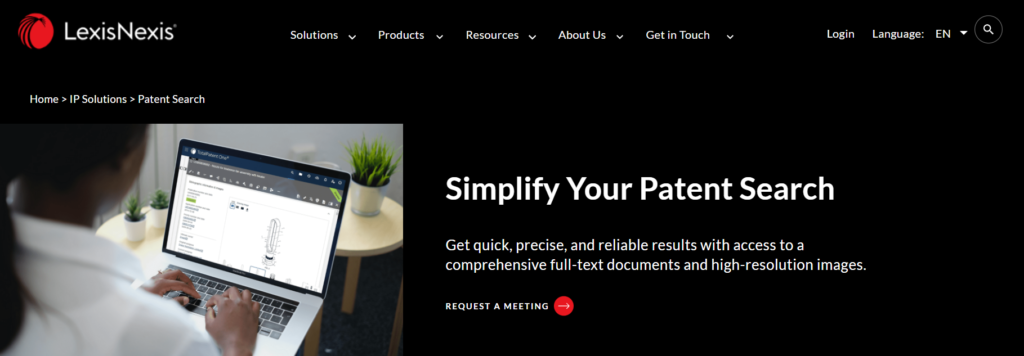
Source – LexisNexis
The database covers more than 160 million patent documents from global authorities, refreshed daily to reflect new filings and legal status updates. Users can search by fields such as titles, abstracts, claims, CPC/IPC codes, and ownership details, and review results with access to high-resolution images and family information. Non-patent literature is also included to widen the search scope.
Pricing: Available by subscription. Detailed pricing is not public and requires contacting LexisNexis for a quote.
Visualize IP is a patent search platform focused on computer vision for design patents.
Instead of manual review, it uses AI to run image similarity searches across a dataset of more than 70 million design images, helping users assess freedom-to-operate, novelty, invalidity, and design landscapes.
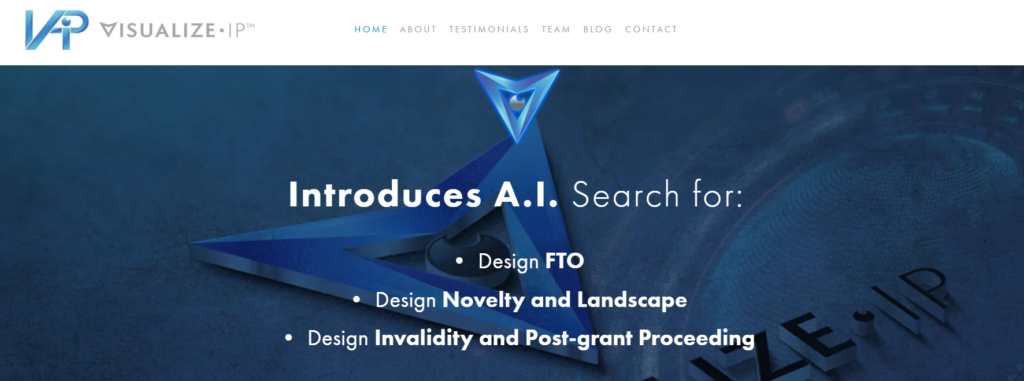
Source – Visualize IP
The platform covers over 58 major design patent jurisdictions and integrates litigation data so users can align searches with current case law and infringement standards.
The results are presented with heatmaps and visual navigation, reducing the time and cost compared to traditional manual searching. Visualize IP is particularly suited for design patent attorneys, in-house IP teams, and firms handling high-volume design work.
Pricing: Subscription-based. The exact costs are not publicly listed and require contacting their team.
The Lens is an open platform that combines patent and scholarly data in a single searchable interface. It provides access to more than 166 million patents from 95+ jurisdictions and 290 million scholarly works, including 68 million open-access articles and 520 million biological sequences.
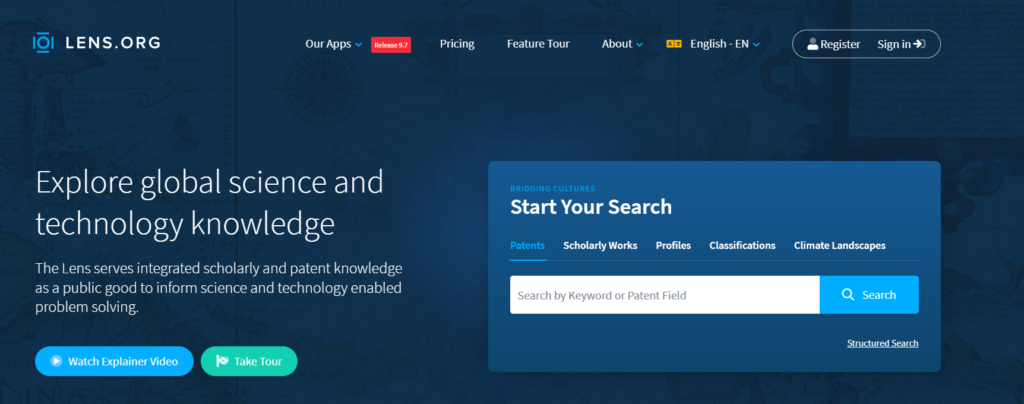
Source – The Lens
The platform supports Boolean, classification, and semantic patent search, alongside tools for portfolio management, citation analysis, and mapping the connections between patents and research publications. Users can also create and share collections for collaborative research.
Pricing: The Lens offers open public access for free, with commercial use starting at $1,000 per year for individual professionals. And enterprise-level institutional accounts begin from $5,000 annually.
INTERGATOR is an AI-supported patent search tool developed by a German firm. It offers hybrid search combining full-text, semantic, similarity, and keyword-based queries, and supports cross-lingual search between languages like German and English.

Source – INTERGATOR
Users can submit documents, paragraphs, or individual terms and see both contextual and exact matches.
The system also has monitoring and alert features for patents, classes, or families, so you can track new filings or legal status changes.
Pricing: They offer a 3-day free trial and subscription details are provided on request.
IamIP is a patent search and monitoring platform designed to help companies and law firms track innovation and competitor activity. The tool combines AI-powered features with global patent data to support prior art search, freedom-to-operate checks, and ongoing competitive intelligence.
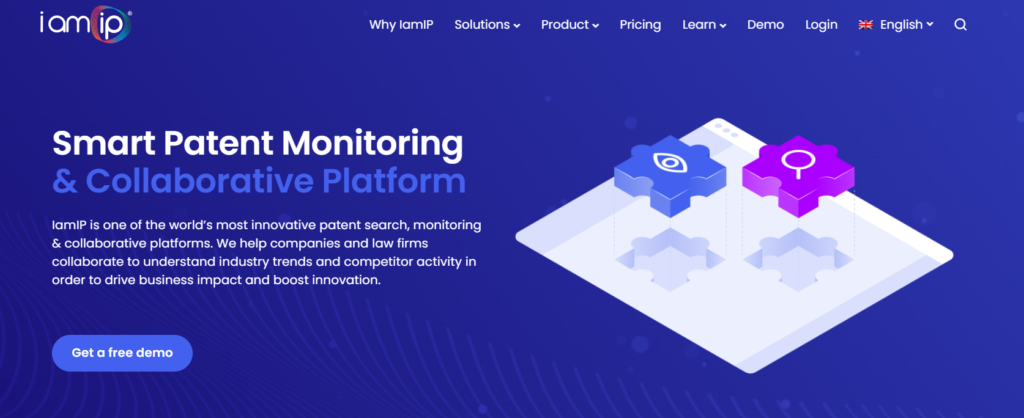
Source – IamIP
Beyond search, its strength lies in automated monitoring and team collaboration. Users can create alerts to track new filings, legal status changes, or updates in specific technology areas, with results refreshed weekly.
The platform also offers AI-assisted tools like the Claim Clarifier, which extracts context-based definitions of claim terms, making reviews easier. The platform also allows teams to build shared portfolios, annotate documents, and manage reviews directly within the platform, reducing reliance on emails or scattered PDFs.
Pricing: They offer three plans with pricing available on request.
AI is reshaping how we approach patent research, but choosing the right patent search tool still requires a careful approach. Here are a couple of tips to keep in mind before you commit to a tool:
Each platform comes with its own balance of features: some focus on simplicity for first-time inventors, while others add depth with analytics, monitoring, or API integrations for enterprise teams.
The right fit depends on where you are in your IP journey and the type of search you need to run.
Prior art searches can reveal sensitive strategy. Before settling on a tool, check how it handles your queries: look for encryption, anonymous or non-tracked searches, and clear data policies. A secure platform ensures your search history isn’t exposed or repurposed.
Together, these pointers can help you evaluate AI platforms with confidence and choose the right fit for your needs.
That said, we feel PQAI is the best choice for users across all spectrums. Here’s why.
PQAI works equally well for inventors, students, and startups new to patent searching as it does for enterprise teams.
For beginners, the platform offers an intuitive, user-friendly interface that inputs your idea and surfaces semantically relevant results across both patents and non-patent literature. And you don’t need to learn Boolean operators or IPC/CPC codes either.
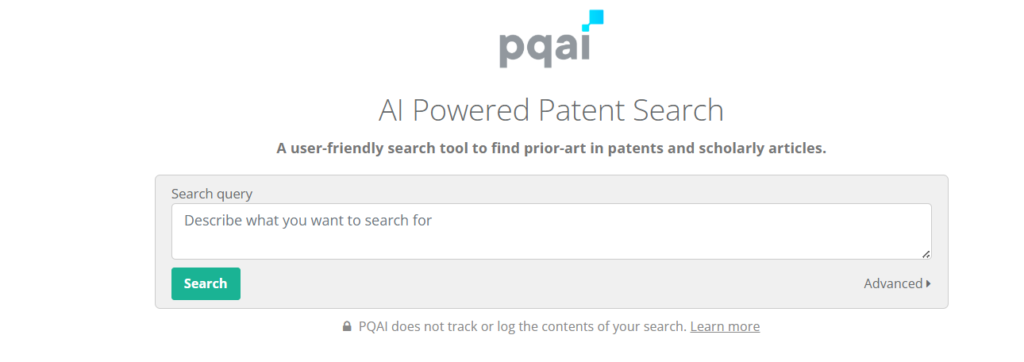
At the same time, every search is encrypted and remains anonymous unless you choose to save your results, ensuring full privacy and security.
For enterprises, PQAI scales further with private server deployments and API integrations, making it possible to run searches at volume and embed them into your own workflows.
Whether you’re testing an idea for the first time or running enterprise-grade searches, PQAI adapts to your needs.
Try PQAI today and experience a smarter, more secure way to search.
Keyword search finds only exact term matches. AI-based search goes beyond words to interpret meaning, concepts, and relationships. This helps you uncover patents written in different terminology, reducing the chance of missing critical prior art.
It is important to check how the platform handles your queries. Look for encryption, anonymous searches, and clear data-use policies. Prior art searches can reveal sensitive strategy, so ensure your provider doesn’t track, store, or repurpose your search history.
Many enterprise-grade tools like PQAI provide APIs and private server options, making it possible to embed AI-powered search directly into R&D or IP management systems. The integration ensures smoother workflows without relying solely on web dashboards.
Free tools are often best suited for novelty checks, learning, or early-stage inventors. Paid plans matter when you need scale, i.e., faster searches, deeper analytics, collaboration features, or bulk API access. It depends on your use case.
Disclaimer: This article is based on publicly available information from company websites and related sources. While we strive for accuracy, some details such as coverage, features, or pricing may change over time. If you notice any discrepancies or updates, please feel free to share them with us so we can keep this content current.
At PQAI, we bring clarity to the world of patents. Through storytelling and insight, we simplify inventions so innovators, researchers, and businesses can learn from the past and build the future.
Share

OpenAI’s Atlas browser marks a new milestone in AI-driven research. Research on the web has always been a bit awkward for AI. It could fetch
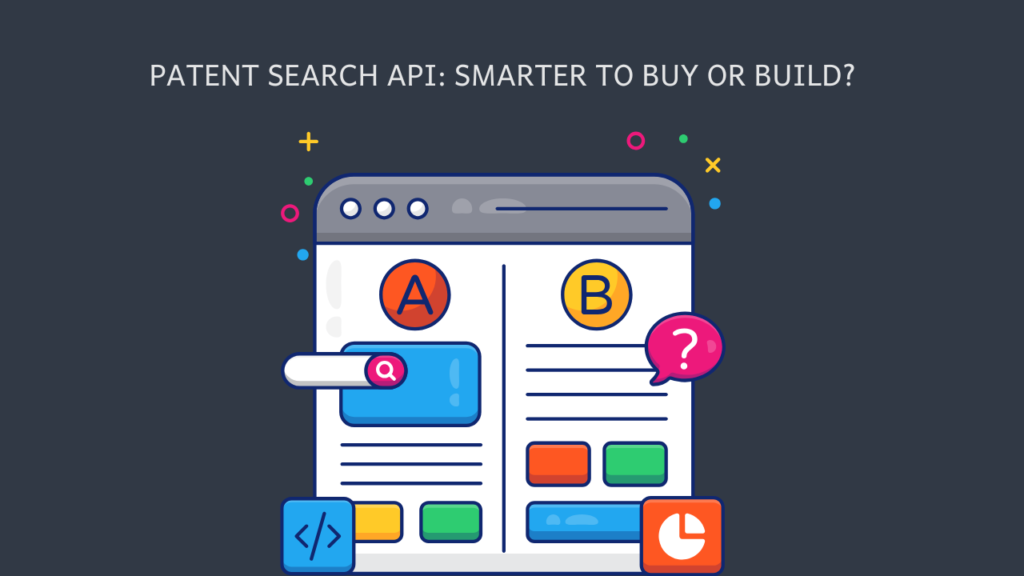
Sooner or later, someone in the boardroom asks: Wouldn’t it be smarter to create our own patent search API instead of licensing one? On the
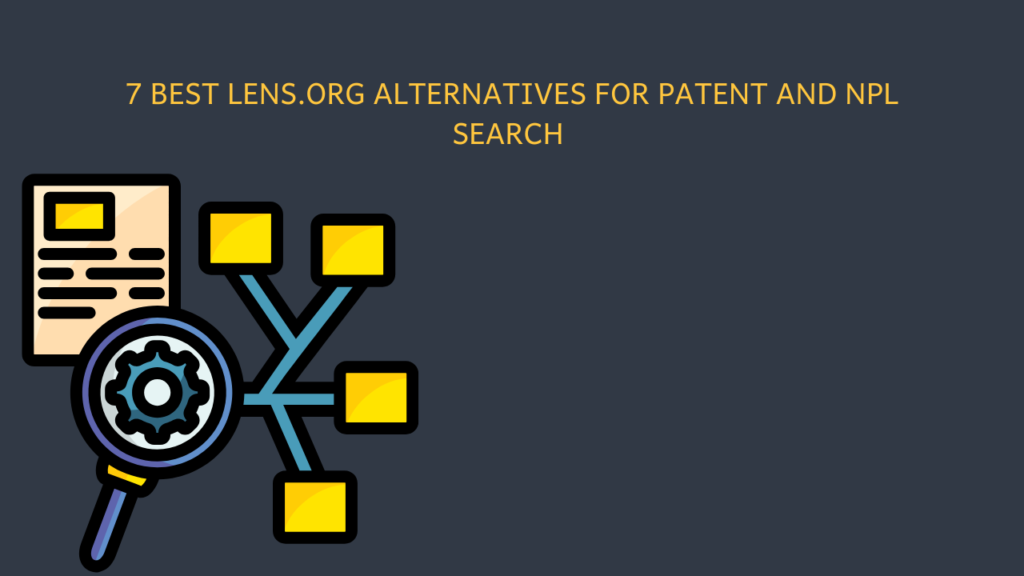
Among open platforms for patent and scholarly search, Lens.org has become a familiar name. With access to both patent and non-patent literature, it has positioned
Dear PQAI Team,
We are pleased to express our support for PQAI and its mission to revolutionize patent searching through open-source, AI-driven solutions.
At [COMPANY NAME], we recognize the importance of accessible and efficient patent tools in fostering innovation and empowering inventors from diverse backgrounds. By supporting PQAI, we aim to contribute to the development of transparent, collaborative, and impactful solutions for the intellectual property community.
We kindly request the addition of [COMPANY NAME] to the official List of Supporters of PQAI.
Sincerely,
[CEO or Equivalent Name]
[Title]
[Company Name]
[Signature]